Western Institute of Technology PDF
Added on 2021-07-05
18 Pages3670 Words211 Views
WESTERN INSTITUTE OF TECHNOLOGY AT TARANAKIDEPARTMENT OF MAORI ENTERPRISE, BUSINESS& TECHNOLOGYBAM6.013 Industrial RelationsNZDB6.635 Employment RelationsAssessment 3 – Training ManualSemester 1, 2021Due: 30 June 2021Contents1.0 Definition of termination.....................................................................................................31NZDB6.635 Employment RelationsAssessment 3 – Training ManualLast Updated 01/07/2021Student ID 2021001189

2.0 Definition and explanation different types of dismissal...................................33.0 Two types of grounds for dismissal..............................................................................44.0 Requirement relating procedural fairness, substantive justification andadequate notice................................................................................................................................55.0 procedure for addressing unsatisfactorily performance..................................76.0 Definition of personal grievance....................................................................................87.0 Grounds for personal grievance......................................................................................99.0 Discrimination............................................................................................................................910.0 Personal grievance procedure.....................................................................................1011.0 Remedies available for employees............................................................................1012.0 Receiving a personal grievance..................................................................................1113.0 Internal dispute resolution procedures..................................................................1214.0 Mediation and authority..................................................................................................1315.0 difference between ER authority and ER court proceedings.....................1316.0 identification and documentation to be file when lodging a mediation request.................................................................................................................................................1417.0 Progressive Warnings for misconduct....................................................................14Appendix :A........................................................................................................................................15Appendix :B........................................................................................................................................17Cases in law linked to specific areas...................................................................................18References............................................................................................................................................192NZDB6.635 Employment RelationsAssessment 3 – Training ManualLast Updated 01/07/2021Student ID 2021001189

Purpose of the training manualPurpose of this manual is make sure that the owner of Kelly-Blue & Co hasunderstand the different aspect of ERA 2000 and its implication.1.0 Definition of terminationTermination refers to ending employee’s employment contract with theorganization. The obligation of good faith is the most important elementwhich needs to be present in the whole process of termination.Situation where termination can take place;-For cause: perform misconduct or incompetence or incapacity.-For redundancy: the role no longer needed,insolvency oforganization, closure or restructuring of workplace.-On notice: as per employment agreement or on reasonable noticeunder common law[ CITATION Ric21 \l 1033 ].2.0 Definition and explanation different types of dismissal- Justifiable dismissal is a situation when employer followed all the legalprocedures to dismiss an employee from the organisation. When dismissingan employee, the employer has to follow Employment Relation Act 2000 toact in good faith and also act as a fair and reasonable employer.The employer must have a good or justified reason and procedural fairnesspresent in order to dismiss an employee. The court will test the justificationunder section 103A of ERA 2000. Depending on the circumstances theemployer has to act accordingly to carry out fairness and justified reason.This is why, it is very important for the employer to know all the informationabout their obligation under the act[ CITATION Rwa20 \l 1033 ]. - Constructive dismissal is when employee is being influenced orpressurized by the employer to resign from the job, it is called constructivedismissal. This is a situation where, employee feels that resignation from thejob is only the option they have left [ CITATION Ric21 \l 1033 ].Constructive dismissal took place where;3NZDB6.635 Employment RelationsAssessment 3 – Training ManualLast Updated 01/07/2021Student ID 2021001189

-The employee has given choice between either resignations ordismissed.-Employer treated the employee in an unfair way continuously so theemployee resigns from the work.- Breach of duty by an employer which leads to staff resignation[ CITATION Ric21 \l 1033 ].3.0 Two types of grounds for dismissal Ground for dismissal means, in what basis or situation the employer mayconsider to dismiss the employee. Dismissal can occur on the basis ofperformance or conduction of the employee[ CITATION Ric21 \l 1033 ].1.Serious misconduct: When the employee involved in some sort ofaction that can leads to serious damage of the relationship of trust andconfidence with the employer, called serious misconduct[ CITATION Empnd1\l 1033 ].This could be;-Performing violent behavior.-Bullying.-Involve in physical or mental harassment-Theft or fraud.-Putting the health and safety of own and others in danger.-Use of illegal drugs at work.-Dishonesty [ CITATION Empnd1 \l 1033 ].The serious misconduct leads to instant dismissal of the employee withoutany notice but there is always remain a question regarding justification ofthe situation and playing good faith obligations. A strong warning can bemore appropriate action to take by the employer for the first offence insteadof instant dismissal[ CITATION Ric21 \l 1033 ].2.Breach of good faith: According to Employment Relation Act (ERA)2000, s3 (a) (I), employment relationships must be built not only on theimplied mutual obligations of trust and confidence, but also on alegislative requirement for good faith behavior (Legislation.govt, 2004).4NZDB6.635 Employment RelationsAssessment 3 – Training ManualLast Updated 01/07/2021Student ID 2021001189

End of preview
Want to access all the pages? Upload your documents or become a member.
Related Documents
Employment Relations Act 2000lg...
|4
|747
|443
Unfair Dismissal Law: Requirements for Capability and Misconduct Issueslg...
|4
|735
|393
Protection from Unfair Dismissal under the Fair Work Act 2009lg...
|5
|1534
|328
Manage Separation and Termination Assignmentlg...
|18
|4354
|65
Employment and Human Rights Law Question 2022lg...
|5
|884
|20
